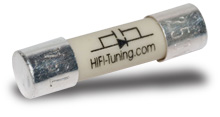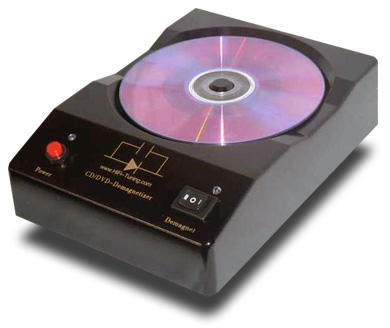March 1, 2010Tweaks . . . That Work! Part Two
 Back in September 2008, I wrote "Plugapalooza"
on SoundStage!, and it turned out to be quite a controversial article.
I still get emails from people asking, "Audio wall plugs? Are you
serious?" Well, yes, I was, and I still am. Tweaking the electrical system that feeds
your audio equipment can offer remarkable performance improvements. And aside from the
outlets I reviewed in 2008, I’ve tried several other electric and electromagnetic
tweaks that are worth consideration. Back in September 2008, I wrote "Plugapalooza"
on SoundStage!, and it turned out to be quite a controversial article.
I still get emails from people asking, "Audio wall plugs? Are you
serious?" Well, yes, I was, and I still am. Tweaking the electrical system that feeds
your audio equipment can offer remarkable performance improvements. And aside from the
outlets I reviewed in 2008, I’ve tried several other electric and electromagnetic
tweaks that are worth consideration.
Power cables have been discussed extensively elsewhere, so
all I’ll say is that I don’t know why the "last few feet" of the
electrical grid makes such a difference -- it simply does. The first part the electricity
entering audio equipment reaches isn’t a transistor, capacitor, or resistor;
it’s a fuse. Electrical fuses have been around since just after the first short
circuit caused a fire. Fuses are simple devices composed of filaments just thick enough to
allow a specified current flow but thin enough to self-destruct when a short circuit
occurs. Most fuses designed for consumer electronics are composed of tin or aluminum
filaments encased in glass tubes, and these are what you’ll find in an inexpensive
disc player or an expensive amplifier. The problem with these fuses should be obvious: the
performance of your expensive electrical outlet and power cable is undermined by a little
tin wire.
Fuses haven’t changed much for the mass market, but
for us audio types fuses have come a long way. HiFi-Tuning’s SilverStar fuses
($39.95), which I use in my reference gear, are to standard fuses what a lawnmower engine
is to a Ferrari V12. As the name implies, SilverStar fuses use a 99.9% pure silver
filament attached to silver end caps. And you won’t find any glass tubes on these
fuses. According to their manufacturer, ceramic turned out to be a much better material
for encasing the filament because it doesn’t resonate like glass. On top of these
innovations, HiFi-Tuning also treats each fuse to a cryogenic bath, which they say further
improves performance.
I can’t say what design aspects of the HiFi-Tuning
fuses are most responsible for their performance, but they offer gains way out of
proportion to their perceived importance in the audio chain and their low price. Tighter
bass and a quieter background were the first things I noticed with these fuses in place
and, thanks to that quiet background, detail was enhanced too. For a tad under $40, these
fuses offer performance improvements of the kind normally associated with a good power
cable or mains filter. They’re an absolute no-brainer tweak that I heartily
recommend.
 When I first heard of CD
demagnetizers, I thought, now here’s a scam -- plastic and aluminum discs aren’t
magnetic! But as these things got into the hands of reputable reviewers, I was more than
surprised to read that they heard definite improvements in sound quality coming from
treated CDs. I later had a chance to try one, and I found that even though the disc
wasn’t made of magnetic material, I could hear a cleaner, more focused sound after it
was demagnetized. When I first heard of CD
demagnetizers, I thought, now here’s a scam -- plastic and aluminum discs aren’t
magnetic! But as these things got into the hands of reputable reviewers, I was more than
surprised to read that they heard definite improvements in sound quality coming from
treated CDs. I later had a chance to try one, and I found that even though the disc
wasn’t made of magnetic material, I could hear a cleaner, more focused sound after it
was demagnetized.
I’m something of a physics geek (kids, pay attention
in science class or you’ll kick yourself later), and though I hardly come close to
understanding most of what physics has to teach, I am aware that magnetism isn’t just
a property found in ferrous metals like iron. Browsing through the McGraw-Hill Encyclopaedia
of Science & Technology, I read that "on an atomic scale, individual atoms
cause magnetic fields when their electrons have a net magnetic moment as a result of their
angular momentum." Angular momentum, it turns out, is "the moment of linear
momentum about an axis" and a magnetic moment is "the relationship between a
magnetic field and the torque exerted on a magnet, a current loop, or a charge that is
moving in the field." To my admittedly untrained mind, the clincher seems to be a
reference in the same publication that mentions "the nuclear magnetism of gold and
copper." If gold can be magnetic on an atomic level, why can’t aluminum and
plastic? Whether that explains how or why a device like HiFi-Tuning’s Ultimate Disc
Demagnetizer ($399) works I leave to the scientists to decide.
Unlike previous generations of demagnetizers, the Ultimate
has a two-stage treatment process, which, according to independent testing conducted for
the manufacturer, makes the HiFi-Tuning device much more effective at eliminating residual
magnetic fields on discs than single-stage types. All I know is that I could hear
the kind of improvements mentioned above in every CD I zapped. Moreover, I had Mrs. Smith
watch a segment of The Simpsons Movie on Blu-ray, and then I treated the disc and
played it again. Without knowing what I did, she took only seconds to ask why the colors
suddenly appeared brighter and more saturated than during the first pass. No, I don’t
know exactly why or how the Ultimate works, but I can tell you that every disc I own got
the treatment before I sent the Ultimate back to its manufacturer.
A couple of years ago I could never have imagined myself
waxing positive about fuses and disc demagnetizers. Money can be wasted on some tweaks,
but not if it’s spent on HiFi-Tuning’s fuses or Ultimate Disc Demagnetizer.
. . . Colin Smith
editor@goodsound.com
|















